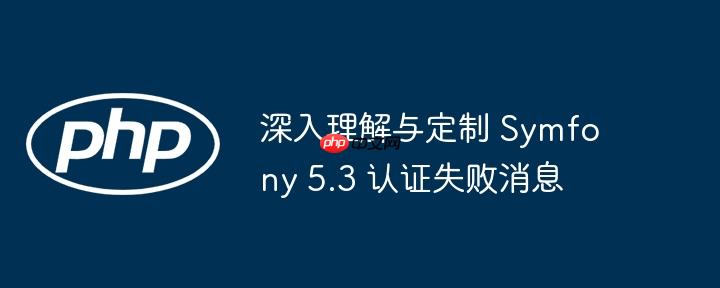深入理解与定制 Symfony 5.3 认证失败消息(定制.失败.理解.消息.认证...)

在 symfony 5.3 及更高版本中,认证流程经过了显著的现代化。当用户尝试登录失败时,我们通常希望显示自定义的错误消息,而不是通用的“凭据无效”。然而,直接在 abstractloginformauthenticator 的 onauthenticationfailure() 方法中抛出 customusermessageauthenticationexception 并不能如预期般工作。要理解其原因并实现定制,我们需要深入了解 symfony 认证失败的内部机制。
onAuthenticationFailure() 的角色:onAuthenticationFailure() 方法并非抛出认证异常的源头,而是 Symfony 认证管理器 (AuthenticatorManager) 在捕获到认证异常后调用的处理器。当认证过程(例如在 authenticate() 或 getCredentials() 方法中)抛出 AuthenticationException 时,AuthenticatorManager 会捕获此异常,并将其传递给当前认证器的 onAuthenticationFailure() 方法进行处理。 默认情况下,AbstractLoginFormAuthenticator 的 onAuthenticationFailure() 会将捕获到的 $exception 对象存储到会话 (session) 中,键名为 Security::AUTHENTICATION_ERROR。
AuthenticationUtils::getLastAuthenticationError() 的作用: 在控制器中,我们通常使用 AuthenticationUtils 服务来获取上次的认证错误,即通过调用 getLastAuthenticationError() 方法。此方法的核心逻辑是从会话中检索之前由 onAuthenticationFailure() 存储的 AuthenticationException 对象。因此,如果在 onAuthenticationFailure() 内部抛出新的异常,它不会被 getLastAuthenticationError() 捕获到,因为该方法只读取会话中已有的错误。
hide_user_not_found 配置的影响: Symfony 的安全组件包含一个名为 hide_user_not_found 的配置选项(默认通常为 true)。当此选项启用时,如果认证失败的原因是用户未找到 (UsernameNotFoundException) 或账户状态异常(非 CustomUserMessageAccountStatusException 类型),Symfony 会自动将原始异常替换为更通用的 BadCredentialsException('Bad credentials.')。这样做是为了防止通过错误消息推断系统是否存在某个用户名,从而增强安全性,避免用户枚举攻击。这意味着即使你在认证流程早期抛出了 CustomUserMessageAuthenticationException,如果它与用户未找到或账户状态相关,并且 hide_user_not_found 为 true,你的自定义消息也可能被覆盖。
要成功定制认证错误消息,核心在于在正确的认证流程阶段抛出 CustomUserMessageAuthenticationException 或 CustomUserMessageAccountStatusException。这些异常将携带你自定义的消息,并最终通过 onAuthenticationFailure() 存储到会话中,供视图层显示。
1. 配置 hide_user_not_found根据你的需求,你可能需要调整 hide_user_not_found 配置。
- 推荐做法: 保持 hide_user_not_found: true。在这种情况下,如果你想为用户未找到或账户状态问题提供自定义消息,应抛出 CustomUserMessageAccountStatusException。对于其他非用户未找到/账户状态的认证失败,则抛出 CustomUserMessageAuthenticationException。
- 可选做法: 将 hide_user_not_found 设置为 false。这将允许 CustomUserMessageAuthenticationException 在所有情况下都直接显示其消息,包括用户未找到的情况。但请注意,这会降低一些安全性。
在 config/packages/security.yaml 中配置:
# config/packages/security.yaml
security:
# ...
hide_user_not_found: false # 根据需求设置为 true 或 false
firewalls:
# ... 2. 在何处抛出自定义异常
自定义异常应在认证流程中实际验证用户凭据或状态的环节抛出。以下是几个关键位置:
a. 在认证器 (Authenticator) 中你的自定义认证器(通常继承自 AbstractLoginFormAuthenticator)是处理用户登录请求的核心。你可以在 authenticate() 或 getCredentials() 方法中进行验证,并在验证失败时抛出自定义异常。
示例:src/Security/LoginFormAuthenticator.php
<?php
namespace App\Security;
use Symfony\Component\HttpFoundation\Request;
use Symfony\Component\HttpFoundation\Response;
use Symfony\Component\HttpFoundation\RedirectResponse;
use Symfony\Component\Security\Core\Exception\AuthenticationException;
use Symfony\Component\Security\Core\Exception\CustomUserMessageAuthenticationException;
use Symfony\Component\Security\Core\Exception\BadCredentialsException;
use Symfony\Component\Security\Http\Authenticator\AbstractLoginFormAuthenticator;
use Symfony\Component\Security\Http\Authenticator\Passport\Badge\CsrfTokenBadge;
use Symfony\Component\Security\Http\Authenticator\Passport\Badge\UserBadge;
use Symfony\Component\Security\Http\Authenticator\Passport\Credentials\PasswordCredentials;
use Symfony\Component\Security\Http\Authenticator\Passport\Passport;
use Symfony\Component\Routing\Generator\UrlGeneratorInterface;
class LoginFormAuthenticator extends AbstractLoginFormAuthenticator
{
private UrlGeneratorInterface $urlGenerator;
public function __construct(UrlGeneratorInterface $urlGenerator)
{
$this->urlGenerator = $urlGenerator;
}
protected function getLoginUrl(Request $request): string
{
return $this->urlGenerator->generate('app_login');
}
public function authenticate(Request $request): Passport
{
$email = $request->request->get('email', '');
$password = $request->request->get('password', '');
$csrfToken = $request->request->get('_csrf_token');
// 假设这里进行一些初步的凭据验证
if (empty($email) || empty($password)) {
// 抛出自定义错误,例如:用户未输入完整信息
throw new CustomUserMessageAuthenticationException('请输入完整的邮箱和密码。');
}
// ... 其他验证逻辑
return new Passport(
new UserBadge($email),
new PasswordCredentials($password),
[
new CsrfTokenBadge('authenticate', $csrfToken),
]
);
}
// onAuthenticationFailure 方法保持其默认行为,它将接收上面抛出的异常
public function onAuthenticationFailure(Request $request, AuthenticationException $exception): Response
{
// 默认实现会将异常存储到会话中,无需在此处再次抛出
if ($request->hasSession()) {
$request->getSession()->set(\Symfony\Component\Security\Core\Security::AUTHENTICATION_ERROR, $exception);
}
$url = $this->getLoginUrl($request);
return new RedirectResponse($url);
}
// ... 其他方法如 onAuthenticationSuccess
} b. 在用户提供者 (User Provider) 中
用户提供者(例如你的 UserRepository)负责从数据源加载用户。如果用户不存在或无法加载,你可以在这里抛出自定义异常。
示例:src/Repository/UserRepository.php
<?php
namespace App\Repository;
use App\Entity\User;
use Doctrine\Bundle\DoctrineBundle\Repository\ServiceEntityRepository;
use Doctrine\Persistence\ManagerRegistry;
use Symfony\Component\Security\Core\Exception\CustomUserMessageAuthenticationException;
use Symfony\Component\Security\Core\User\UserProviderInterface;
use Symfony\Component\Security\Core\User\UserInterface;
use Symfony\Component\Security\Core\Exception\UnsupportedUserException;
use Symfony\Component\Security\Core\Exception\UsernameNotFoundException; // 旧版本使用
/**
* @extends ServiceEntityRepository<User>
* @implements UserProviderInterface
*/
class UserRepository extends ServiceEntityRepository implements UserProviderInterface
{
public function __construct(ManagerRegistry $registry)
{
parent::__construct($registry, User::class);
}
/**
* Used to upgrade (rehash) the user's password automatically over time.
*/
public function upgradePassword(UserInterface $user, string $newHashedPassword): void
{
if (!$user instanceof User) {
throw new UnsupportedUserException(sprintf('Instances of "%s" are not supported.', \get_class($user)));
}
$user->setPassword($newHashedPassword);
$this->getEntityManager()->persist($user);
$this->getEntityManager()->flush();
}
/**
* Loads the user for the given user identifier (e.g. username or email).
*
* @throws CustomUserMessageAuthenticationException If the user is not found.
*/
public function loadUserByIdentifier(string $identifier): UserInterface
{
$user = $this->findOneBy(['email' => $identifier]);
if (!$user) {
// 如果 hide_user_not_found 为 true,此异常可能被 BadCredentialsException 覆盖
// 如果希望显示此消息,可以考虑 CustomUserMessageAccountStatusException 或禁用 hide_user_not_found
throw new CustomUserMessageAuthenticationException('该邮箱未注册。');
}
return $user;
}
// 如果你的 Symfony 版本仍然使用 loadUserByUsername,请确保它调用 loadUserByIdentifier
public function loadUserByUsername(string $username): UserInterface
{
return $this->loadUserByIdentifier($username);
}
} c. 在用户检查器 (User Checker) 中
用户检查器 (UserChecker) 允许你在用户认证之前 (checkPreAuth) 和之后 (checkPostAuth) 执行额外的检查,例如账户是否已启用、是否已锁定或密码是否过期。
示例:src/Security/UserChecker.php
<?php
namespace App\Security;
use App\Entity\User; // 假设你的用户实体是 App\Entity\User
use Symfony\Component\Security\Core\User\UserInterface;
use Symfony\Component\Security\Core\User\UserCheckerInterface;
use Symfony\Component\Security\Core\Exception\CustomUserMessageAccountStatusException;
use Symfony\Component\Security\Core\Exception\AccountExpiredException;
use Symfony\Component\Security\Core\Exception\DisabledException;
use Symfony\Component\Security\Core\Exception\LockedException;
use Symfony\Component\Security\Core\Exception\CredentialsExpiredException;
class UserChecker implements UserCheckerInterface
{
/**
* Checks the user account before authentication.
*
* @throws CustomUserMessageAccountStatusException
*/
public function checkPreAuth(UserInterface $user): void
{
if (!$user instanceof User) {
return;
}
// 示例:检查用户是否被禁用
if (!$user->isActive()) { // 假设 User 实体有一个 isActive() 方法
throw new DisabledException('您的账户已被禁用,请联系管理员。');
// 或者使用 CustomUserMessageAccountStatusException
// throw new CustomUserMessageAccountStatusException('您的账户已被禁用,请联系管理员。');
}
// 示例:检查账户是否过期
// if ($user->isAccountExpired()) {
// throw new AccountExpiredException('您的账户已过期,请重新激活。');
// }
}
/**
* Checks the user account after authentication.
*
* @throws CustomUserMessageAccountStatusException
*/
public function checkPostAuth(UserInterface $user): void
{
if (!$user instanceof User) {
return;
}
// 示例:检查密码是否过期
// if ($user->isPasswordExpired()) {
// throw new CredentialsExpiredException('您的密码已过期,请重置。');
// }
// 示例:检查账户是否锁定
// if ($user->isLocked()) {
// throw new LockedException('您的账户已被锁定,请稍后再试。');
// }
}
} 别忘了在 security.yaml 中配置你的用户检查器:
# config/packages/security.yaml
security:
# ...
providers:
app_user_provider:
entity:
class: App\Entity\User
property: email
firewalls:
main:
lazy: true
provider: app_user_provider
form_login:
login_path: app_login
check_path: app_login
# ...
# 注册你的用户检查器
user_checker: App\Security\UserChecker
# ... 视图层显示自定义错误
一旦自定义异常在上述某个阶段被抛出并存储到会话中,你的 Twig 模板就可以通过 error.messageKey|trans 过滤器来显示它。AuthenticationUtils::getLastAuthenticationError() 返回的异常对象,其 messageKey 属性将包含 CustomUserMessageAuthenticationException 或 CustomUserMessageAccountStatusException 构造函数中传入的消息。
示例:templates/security/login.html.twig
{# ... 其他 HTML 代码 ... #}
{% block body %}
<form method="post">
{% if error %}
{# error.messageKey 将是你在 CustomUserMessageAuthenticationException 中传入的消息 #}
<div class="alert alert-danger">{{ error.messageKey|trans(error.messageData, 'security') }}</div>
{% endif %}
{# ... 登录表单字段 ... #}
<button class="btn btn-lg btn-primary" type="submit">
登录
</button>
</form>
{% endblock %} 注意事项
- 不要直接修改 Symfony 核心类: 始终通过继承来扩展 Symfony 的核心功能,而不是直接修改 vendor/symfony 目录下的文件。这确保了你的项目能够顺利升级,并遵循最佳实践。
- 保持 onAuthenticationFailure() 简洁: onAuthenticationFailure() 的主要职责是处理认证失败后的响应(例如重定向),而不是决定具体的错误消息内容。让更早的认证环节来决定错误消息。
- 安全性与用户体验的平衡: hide_user_not_found 配置是安全性考量。在定制错误消息时,要权衡用户体验和潜在的安全风险。通常,建议保持 hide_user_not_found: true,并使用 CustomUserMessageAccountStatusException 来提供更具体的账户状态错误。
- 翻译: 如果你的应用支持多语言,记得为 CustomUserMessageAuthenticationException 或 CustomUserMessageAccountStatusException 中使用的消息键提供翻译。
在 Symfony 5.3 中定制认证失败消息,关键在于理解其背后的异常处理流程。通过在认证器、用户提供者或用户检查器等认证管道的早期阶段抛出 CustomUserMessageAuthenticationException 或 CustomUserMessageAccountStatusException,并结合 hide_user_not_found 配置的合理设置,你将能够实现灵活且用户友好的错误提示,从而显著提升用户体验。记住,始终遵循 Symfony 的最佳实践,通过扩展而非修改核心类来定制功能。
以上就是深入理解与定制 Symfony 5.3 认证失败消息的详细内容,更多请关注知识资源分享宝库其它相关文章!
